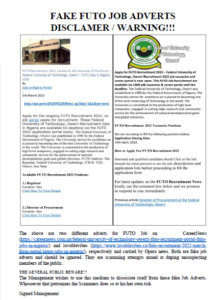1) Full -Time: A minimum of 4 semesters and a maximum of 8 semesters.
2) Part – Time: A minimum of 6 semesters and a maximum of 12 semesters.
*L – Lecture, T – Tutorial, P – Practical
Course Outline
Ph.D. CLINICAL OPTOMETRY – HARMATTAN SEMESTER
| S/No | Code | Course Title | L | T | P | Units |
| 1 | OPT 901 | Advances in Binocular Vision | 1 | 0 | 2 | 3 |
| 2 | OPT 903 | Pediatric Optometry | 1 | 0 | 2 | 3 |
| 3 | OPT 905 | Advanced Contact lens | 1 | 0 | 2 | 3 |
| 4 | OPT 907 | Advanced Glaucoma | 1 | 0 | 2 | 3 |
| 5 | OPT 909 | Advances in Ophthalmic Examination | 1 | 0 | 2 | 3 |
RAIN SEMESTER
| S/No | Code | Course Title | L | T | P | Units |
| 1 | OPT 918 | Dissertation | 0 | 0 | 6 | 6 |
RAIN SEMESTER
| S/No | Code | Course Title | L | T | P | Units |
| S/No | Code | Course Title | L | T | P | Units |
| 1 | OPT 908 | Research Methods and Applied Data Analysis | 1 | 1 | 1 | 3 |
| 2 | OPT 910 | Seminar | 0 | 0 | 3 | 3 |
| 3 | OPT 912 | Advanced Retinal Imaging | 1 | 0 | 2 | 3 |
| 4 | OPT 914 | Perceptual And Spatial Organization of Vision | 1 | 0 | 2 | 3 |
| 5 | OPT 916 | Advanced Quantitative Methods for Vision Research | 1 | 1 | 1 | 3 |
| TOTAL | 15 | | | | | |
OPT 901: Advances in Binocular Vision
Advances in sensory and motor mechanisms in binocular vision. Research on neurological basis for binocular vision. Advances in the clinical management of binocular vision anomalies including strabismus, amblyopia, heterophorias, suppression, eccentric fixation, anomalous retinal correspondence.
OPT 908: Research Methods and Applied Data Analysis
Basic knowledge in proposal writing, health statistics, formulation of a research problem, research design, clinical trials, measurement of variables, data analysis using higher statistical softwares – SPSS, EPI INFO.
OPT 910: Seminar
Students are to present a seminar in an approved topic in Vision Science.
OPT 911: Fundamentals of Vision Science
A comprehensive insight on vision science; visual cognition, visual illusions, eye movements, saccades, eye tracking, visual crowding, visual masking, spatial vision.
OPT 912: Advanced Retinal Imaging
Recent advances in the methods used in imaging the human retina. Types of illumination and delivery methods, optical techniques for detection, interaction of light and tissues, systems integration, and selection of imaging modalities based on scientific goals.
OPT 913: Advanced Optics and Dioptrics of the eye
Basic principles of classic and modern geometric and physical optics with emphasis on dioptrics of the human eye. Schematic eye, aberrations and entoptic phenomena.
OPT 914: Perceptual and Spatial Organization of Vision
Classical perceptual psychology, computational modeling and neuroscience, perception of color grouping, odal and amodal completion, object recognition, visual attention, visual memory, visual imagery and visual awareness. Human spatial vision and spatial localization. Vision analogues and models of visual processing of spatial information. Perception: visual direction, egocentric and oculocentric localization.
OPT 915: Advanced Color Vision and Visual Sensitivity
Advances in sensory aspects of light and color vision. Mechanisms of normal and defective color vision. Specification, discrimination, psychophysics, and neurophysiology of color processing.
OPT 916: Advanced Quantitative Methods for Vision Research
Further studies in the sensory nerve code, representation of nerve messages by orthogonal functions, sampling theorem, linear filters, Fourier analysis in one and two dimensions, analysis of directional data, stochastic processes, and signal detection theory.
OPT 917: Neurophysiology and Perceptual Development
Further studies of receptive fields, their characteristics and associated visual functions. Development of visual pathways and studies of abnormal visual exposure. Development of nervous and perceptual systems. Innate and environmental factors in development of central visual pathways.
OPT 918: Dissertation
Students are to carry out a scientific research in an approved topic relating to Vision Science. Students will face an oral defense before a panel including an external examiner.


